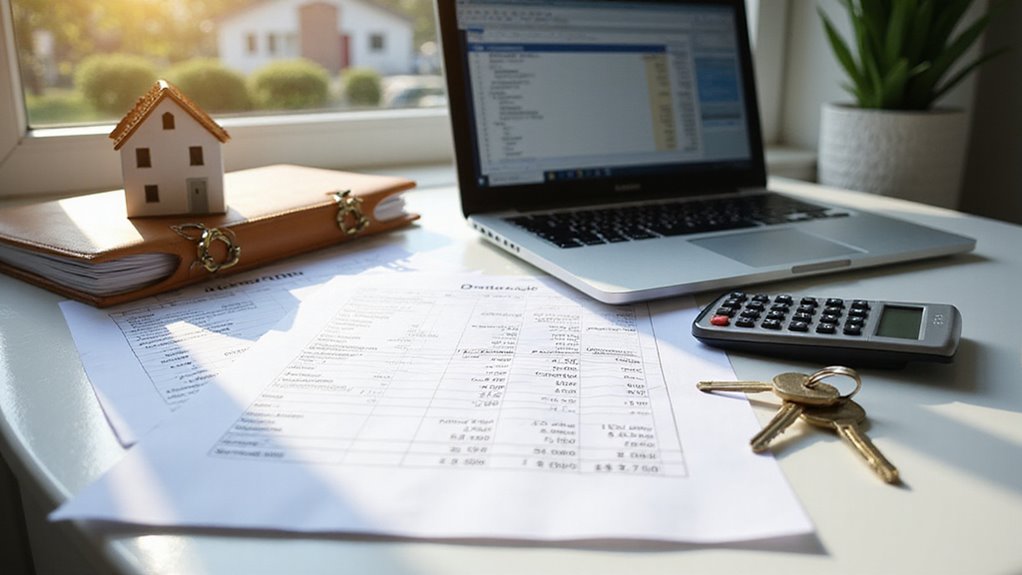Pricing a rental property for sale can be confusing. Many owners do not know where to start or what factors matter most. A wrong price can mean wasted time and lost money.
This problem gets worse if you ignore key details. Buyers might walk away, or you might accept less than your property is worth. Setting the right price is not just about guessing or copying others.
The best way to price a rental property for sale is to use local market data and rental income analysis. This approach gives you a clear, fair number that attracts serious buyers. It also protects you from costly mistakes. This blog will guide you step by step to set the right price for your rental property.
Key Takeaways
- Analyze recent sales of comparable rental properties in the same area to establish a pricing benchmark.
- Assess the current rental income, occupancy rates, and tenant stability to demonstrate investment potential.
- Adjust the price for unique property features, renovations, or needed repairs to reflect true market value.
- Calculate the Net Operating Income (NOI) and apply a realistic cap rate based on local market data.
- Consult with real estate professionals to ensure accurate pricing and leverage their market expertise.
Assessing the Local Real Estate Market

Assessing the local real estate market helps you set the right price for your rental property. You should start by checking recent market reports and local vacancy rates. These numbers show how much demand exists for rentals like yours. Reviewing recent sales of comparable homes in the area can also give you a good benchmark for pricing. Luxury features can increase rental prices if they are popular in your area. If your property has historical value, it might attract tenants willing to pay more. Properties in landmark districts or with unique design often rent faster.
Average days on market and rental yields provide useful benchmarks. You should compare these figures to similar properties near you. If your property performs better, you can consider a higher price.
Using clear, measurable data gives you a strong understanding of your position in the market. This approach helps you match your price to real demand. If you follow these steps, you are more likely to maximize your return. For properties with unique features, hiring an appraiser can help determine an accurate listing price when market analysis alone is not enough.
Analyzing Comparable Property Sales
To price your rental accurately, you’ll need to identify comparable properties with similar size, age, and amenities. Analyze recent sale prices for these properties to establish a reliable value range. Then, adjust for any unique features or upgrades your property offers to refine your pricing strategy. It’s also important to consider whether your property has a marketable title, as this can significantly impact buyer confidence and final sale price. Ensuring an accurate market value assessment based on comparable sales is crucial to avoid overpricing and attract serious buyers.
Identifying Similar Property Types
To price your rental property, you must find similar properties called “comps.” These comps should match your property in location, size, age, and amenities. Choosing the right comps helps set a realistic price.
You should look for comps with similar square footage and layout. It is important to compare luxury upgrades and property staging as well. These features can affect how buyers see the property and its value.
Use recent sales or listings within a half-mile and in the same school district. If properties differ slightly in finishes or amenities, values may change. Always review features carefully to make accurate comparisons.
Evaluating Recent Sale Prices
To find your property’s market value, look at recent sale prices of similar homes. Compare properties that match yours in size, age, and location. Use sales from the last six to twelve months for accuracy.
If a property had good tenant screening and clear landlord rules, it often sold for more. Buyers see these features as lower risk. This can make your property more attractive.
You should also check each comp’s price per square foot and rental income. Review their occupancy history for extra insight. If you use these numbers, you will set a fair and competitive price.
Adjusting for Unique Features
Unique features can raise your rental’s value above similar properties. Items like luxury amenities or special designs often mean you can ask for a higher price. If your rental has standout features, you should adjust your price accordingly.
For example, a rooftop deck or a smart home system can justify a higher rent. Buyers may pay more for special finishes or efficient upgrades. These features make your property more desirable.
| Feature | Market Impact | Value Adjustment |
|---|---|---|
| Luxury Amenities | High | +$20,000 |
| Architectural Style | Moderate-High | +$10,000 |
| Standard Upgrades | Low-Moderate | +$5,000 |
You should use recent sales data to set these adjustments. Compare your rental with others to find a fair price. This method helps you set a price that matches your property’s true value.
Evaluating Current Rental Income
Current rental income shows how much a property is earning right now. You should check the rent roll and lease agreements for clear information. This review helps set a realistic price for the property. Rent rolls list the total rent collected each month and each year. Lease agreements show rent increases or discounts that may apply. If any concessions exist, you must account for them in your analysis. Tenant payment records can reveal if there are late or missed payments.
If tenants often pay late, future income may be less reliable. Consistent payments suggest steady income. Landlord duties also affect net income. If the landlord pays many expenses, the actual profit may be lower. You should factor these costs into your final calculation. If you want to avoid home-selling complexities, considering a cash sale option can simplify the process and reduce risk. Before finalizing your price, it’s wise to verify that the property has a clear title to prevent legal issues that could affect the sale or transfer of ownership.
Factoring in Occupancy Rates

Strong occupancy rates help you price a rental property correctly. High occupancy means steady demand and can lead to a higher sale price. Low occupancy can lower your property’s value.
Historical data shows how often your property sits empty. If vacancies last long, your income drops and buyers may worry. Shorter vacancy periods suggest a stable rental market. Properties with low maintenance costs are also more attractive to investors because they help keep overall expenses down.
Tenant turnover rates also matter. Frequent turnover increases cleaning, repair, and marketing expenses. Lower turnover usually means higher profits.
Compare your property’s data with local averages. If your property performs better, mention this to buyers. Reliable income streams attract more investors.
If you consider occupancy rates, your valuation will be more accurate. Buyers want proof of steady income, not just high rent figures. Data-driven pricing builds confidence in your property.
If your rental property is subject to any existing liens, understanding their impact on occupancy and sale price is crucial for an accurate valuation.
Reviewing Lease Terms and Tenant Stability
To review lease terms and tenant stability, check if your leases are solid and if tenants pay on time. Stable tenants and clear leases can raise your property’s value. Buyers prefer properties with reliable income.
Start by checking how often tenants pay rent and if they pay on time. If most tenants pay late, property value may decrease. Consistent payments suggest good tenant stability. Properties with a history of overdue payments can also signal emotional or financial stress, which may affect negotiations with potential buyers.
Next, look at how much time remains on each lease and if the terms are enforceable. Longer leases with clear rules make your property more attractive. Short leases or weak terms could worry buyers.
If the lease renewal terms are fair and encourage tenants to stay, your property may have fewer vacancies. Favorable renewal options can mean longer tenant stays. Short or strict renewals may cause more turnover.
You should also look for patterns of tenant turnover or empty units. High turnover or many vacancies can lower income and property value. If you see stable occupancy, it signals a dependable investment. When preparing to sell, remember that capital gains taxes may apply if your property has appreciated in value since you acquired it.
Calculating Net Operating Income

Net Operating Income (NOI) shows how much income your property earns after expenses. To calculate NOI, start with total annual rental income. Subtract all operating expenses from this amount. Common expenses include property tax, insurance, maintenance, management fees, and owner-paid utilities. Do not include mortgage payments, as NOI excludes debt costs.
NOI helps you compare your property to similar ones for accurate pricing. Reviewing a title report before listing can also reveal any issues that might impact your expenses or the sale process. If you calculate NOI correctly, buyers can see how well your property generates income. They often use NOI to decide if your property is a good investment. Always use accurate figures to set a fair and competitive price.
It’s important to also consider any structural repairs that may be needed, as issues like termite damage can affect both expenses and the final sale price.
Considering Property Condition and Upgrades
You need to objectively assess interior wear, as visible deterioration can lower your property’s market value. Analyze the impact of recent renovations, since updated features often justify higher price points. Don’t overlook appliance age, because outdated systems may signal future costs to potential buyers.
Before setting your price, consider how joint ownership or other legal factors might affect your ability to sell, especially if the property is owned with a spouse or another party. When pricing your rental, it’s also important to factor in necessary repairs since leaving them unaddressed can affect both the selling price and buyer interest.
Assessing Interior Wear
Assessing interior wear means checking how much the inside of the home shows use or damage. Interior condition and upgrades affect the sale price. Buyers notice every detail, so it is important to check carefully.
Interior decor should be modern and neutral. Outdated fixtures or colors can make the home less appealing. Updated decor attracts more buyers.
Paint condition matters to buyers. Fresh paint makes rooms look clean and cared for. If walls are peeling or faded, buyers may lower their offers.
Flooring shows how much the home has been used. Worn carpets or scratched floors signal extra costs for buyers. Durable, clean floors increase a home’s value.
Appliance age impacts the home’s appeal. Old or broken appliances reduce value. Newer appliances can help you ask a higher price. If you evaluate these factors honestly, you can set a fair and competitive price.
Evaluating Recent Renovations
Recent renovations can change how much your property is worth. You should check the quality, type, and age of any updates. Good renovations often make a property more valuable.
Start by listing all changes, such as new kitchens, bathrooms, or floors. Keep receipts or permits if you hired professionals. These records help prove the work was done well.
High-quality upgrades can attract better tenants. If the renovations make the home safer or save energy, you might charge more rent. Improvements that tenants want often lead to more interest from qualified renters.
If you want to set the right price, look at similar local homes with recent updates. Compare your property with others that had the same kind of work done. This helps you price your rental fairly and reflect your investment.
Factoring Appliance Age
The age of appliances affects your property’s value and rental price. Buyers and renters often look at how old the appliances are. Older or poorly maintained appliances may lower your property’s appeal.
Most appliances lose value after 5 to 10 years. Good maintenance records can show the property is well cared for. If you keep these records, people may trust your property more.
Buyers will consider the cost to replace old appliances. If appliances are outdated, they might offer a lower price. Newer appliances with better energy efficiency can attract more interest.
If you adjust your price based on these factors, you can stay competitive. Properly managed appliances can set your property apart. Consider these points to improve your market position.
Weighing Location and Neighborhood Appeal
Location strongly affects a property’s value and appeal. If you want to price a property right, you must review the neighborhood. Consider both the immediate area and what is nearby.
You should check local crime statistics to understand safety. Buyers and renters often prefer safe neighborhoods. If crime rates are high, prices may need to be lower.
Amenities like parks, schools, and public transport also matter. If these are close by, demand for your property may rise. If not, property value could be affected.
Recent sales and rental data can help you compare prices. You should look at similar properties in the area. If prices are dropping, you may need to adjust your pricing.
Demographic trends and future neighborhood growth can guide your strategy. If a neighborhood is growing, prices could increase over time. If growth is slow, you might need to price more competitively.
If you use these factors, your pricing will reflect both the location and the neighborhood appeal. This helps make your property more attractive to buyers and renters. You also improve your chances of getting the best possible return.
When setting your price, using a comparative market analysis can help you determine the true market value based on recent local sales.
Understanding Cap Rate Expectations

Cap rate expectations help you set a fair price for your property. The cap rate shows net income compared to the property’s market value. Investors look at cap rates to judge possible returns.
You should check recent sales of similar properties with luxury features. If luxury amenities or history add value, buyers may accept lower cap rates. Local market trends are important when setting your expectations.
Look at average cap rates for your property type, such as multifamily or single-family homes. You should also consider how property condition or strong tenants affect value. If your property stands out, you might justify a lower cap rate.
Serious buyers are more likely if your price matches market expectations. Always adjust your price based on data and market feedback. If you follow these steps, you will set a realistic cap rate.
Accounting for Future Development Plans
You need to factor in upcoming zoning changes, as they can significantly alter your property’s value. Track nearby development projects, since new infrastructure or commercial spaces often boost tenant demand and future appreciation. Rely on municipal planning data and recent case studies to quantify these effects accurately.
Zoning Changes Impact Value
Zoning changes can raise or lower a property’s value. These rules decide how you can use the land. If zoning shifts, what you can do with the property may change.
You should check city plans and future zoning proposals. If regulations allow more uses, the property could become more valuable. If rules tighten, the value may drop.
Review city council meetings for zoning topics. Talk to local planning offices for advice. If you learn about zoning changes early, you can set a better price.
Nearby Projects Influence Demand
New projects like shopping centers or transit stations can increase demand for nearby rental properties. If these developments are close, rental rates can rise by up to 15%. This makes your property more attractive to buyers.
You should check recent market data to estimate the impact of these projects. If demand grows, expect higher rental income but also higher property taxes. These changes can affect your net operating income.
When setting your sale price, include the benefits and costs of nearby projects. If you factor in higher rent and possible expenses, your price will be more accurate. This approach helps attract serious buyers who value future growth.
Working With Real Estate Professionals

Partnering with experienced real estate professionals can help you sell your rental property for a higher price. Experts know the market and can guide you through each step. Their support often leads to a faster and smoother sale.
Real estate professionals set the right price using local data. They understand how to highlight your property’s best features. If you need advice on tenant issues, they can offer solutions.
Agents use effective marketing to reach more buyers. They also help with paperwork and legal requirements. If you worry about compliance, agents can reduce your risk.
Working with professionals gives you confidence in your sale process. If you want the best results, their expertise is valuable.
Incorporating Tax Implications
Tax rules can change what you actually earn when selling your rental property. You need to look at these rules before setting a price. This helps you know how much money you will keep after taxes.
Capital gains taxes may lower your profit if your property increased in value. You should also consider tax breaks you claimed for mortgage interest, repairs, and property taxes. If you used these deductions, your taxable income during ownership was already reduced.
Depreciation claimed during ownership will affect your taxes when you sell. Depreciation recapture means you might owe extra taxes at sale. You can calculate your adjusted cost basis by adding your purchase price, improvements, and closing costs, then subtracting total depreciation.
Knowing your cost basis helps you see your possible tax bill. If you understand these tax factors, you can set a sale price that fits your after-tax earnings. This way, you protect your investment and avoid surprises.
Adjusting for Unique Features and Amenities
Adjusting for unique features and amenities means checking how special aspects of your property affect its value. You should compare your property to others that have sold recently. If a feature raises prices in the market, you can adjust your value estimate.
Modern furniture arrangements can make a home feel more inviting and may increase its value. Landscaping by a professional often adds curb appeal and can lead to higher sale prices. Upgraded appliances, like smart devices or energy-saving models, usually attract better offers.
Extra amenities such as pools or home offices may support a higher price if they are uncommon in your area. You need to use sales data to estimate how much each feature is worth. If you find a clear pattern, you can use it to set a fair price.
Setting a Competitive Asking Price
A competitive asking price attracts buyers and helps your property sell faster. You should look at recent sales of similar properties in your area. If you study homes sold in the last three to six months, you will get a good price range.
The number of similar homes for sale affects your price. Many listings mean you may need to lower your price to attract interest. If few properties are available, you can often set a higher price.
You should consider the time of year, as demand changes with the seasons. Market activity is usually higher in spring and summer. Use local real estate data to help set your price and avoid missing out on buyers or profits.
Conclusion
If you want to sell your rental property quickly and for the best price, accurate pricing is essential. Sellers who rely on data and market research set themselves up for success. If you take the time to analyze comparable properties and rental income, you can avoid costly mistakes.
If you skip thorough research, you could leave money on the table or struggle to attract buyers. Sellers who use professional tools and insights often see faster results. If you want to avoid the hassle, we buy houses for cash in any condition.
If you are ready to sell, Greg Buys Houses can make the process simple and fast. If you contact us today, we will give you a fair cash offer. Let us help you take the next step with confidence.

